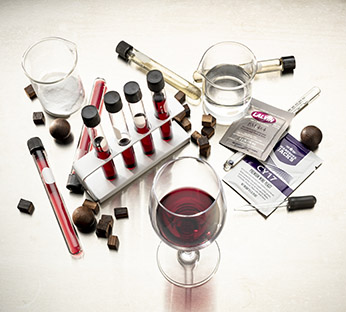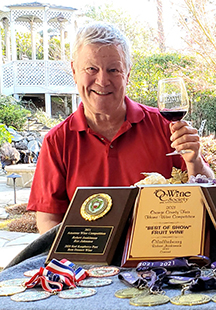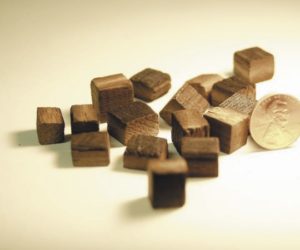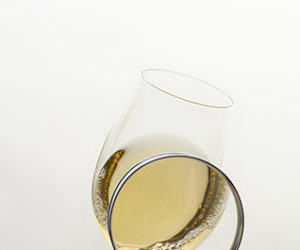
Making wine from a kit of concentrated juice is a great way for those curious about dipping their toes into the hobby of winemaking to create their first batch. With the exception of adding water, the kit includes all of the ingredients needed to make a fantastic wine by simply following the included instructions. But kits are not just for newbies. They offer the opportunity to make wines year-round and many longtime winemakers who grow or buy grapes for their wine each fall also turn to kit winemaking during the slower months of their hobby.
While kit manufacturers always recommend following the directions (for good reason — the kits were designed to result in success every time if made correctly) home winemakers are a curious and experimental bunch by nature. This often leads to exploration and adjustments outside of the directions — from fermentation temperature, aging times, or the amount of water added, to changing up yeasts, adding ingredients not called for, and much more. Dessert wine kits are some of the most fun to play with, as these kits are almost begging to be fortified to enhance the Port-style nature and add a whole new dimension of complexity to the sweet base.
A large percentage of the entries into the Port Style and other dessert categories of the WineMaker International Amateur Wine Competition each year are made from kits (and, as you’ll see in our “Top 100 Wine Kits of 2022” feature). Though the list in our Top 100 are the highest scoring wines made 100% from kits and leave out another block of entrants made with kit wine bases that are then modified. These entries are some of the most fun that we see each year as you never know what an amateur winemaker will think of adding. We’ve seen additions of fruit juices, a gamut of liquors and spirits, chocolate, blended kits, and on and on.
If you have thought about modifying your own dessert kit wines but aren’t sure where to start, we’ve got you covered. We reached out to three top amateur winemakers with a wide array of winemaking experiences to pick their brains about how they have gone about dessert kit wine modifications that earned medals in our 2022 competition.

Mike Dault lives in Edgewood, Kentucky, where he maintains a small backyard vineyard of Cabernet Franc vines and is a member of the home winemaking Cincinnati Vintners Club. His winemaking focus the past four years has been fruit and Port-style wines, resulting in three Best Of Show awards during that time and being named the 2021 Winemaker of the Year in the WineMaker International Amateur Wine Competition.
How did you get into making dessert kit wines?
I started making dessert wine in 2013 with a hazelnut kit I got while visiting Canada. I love hazelnut coffee and was excited to try it. I drank the last bottle from that batch last year and was not disappointed.
How many dessert kit wines have you made? Of those, how many have you strayed from the directions to create a unique wine from?
After the success of the hazelnut wine I began making two or more different types of dessert kit wines per year — so I’ve made about 20 by now. I didn’t start deviating from the manufacturer instruction until after about five years as I was really happy with the taste of the wines without intervention.
Any recommendations for those who have never strayed from the directions before we jump into your own experiences?
I would make a few by following the directions so you have a base to work from and can familiarize yourself with the kit-making process. Once you feel comfortable, then I would start with breaking the 3-gallon (9.5-L) kits into three 1-gallon (3.8-L) batches and try different yeasts/or alcohol additions like different brandies or Everclear in different amounts.
What types of significant changes have you made to dessert-style wine kits?
The common changes I’ve made are different yeast, alcohol additions, and fermentation temperature. I may occasionally do a chaptalization or blend different dessert wine kits like caramel and raspberry chocolate or even coffee dessert together.
Take me through the planning and trial process you go through when you decide to stray from the kit instructions.
I review my notes from previous batches made to see what really worked or if I might try some change in the future. As mentioned, breaking into separate fermentations provides an easy way to tell what works for you and what doesn’t, and since they are just 1-gallon (3.8-L), it doesn’t hurt so much if an experiment doesn’t work out.
When fortifying a dessert wine, what types of fortifiers have you used, and at what quantities would you recommend?
I first tried Everclear in 2017; however, it was too hot (strong alcohol taste). I then switched to different types of brandy and found 300–500 mL a good amount for a 3-gallon (9.5-L) batch or 100–165 mL for 1-gallon (3.8-L) batches. Starting on the low end is smart because you can always add more. I remember experimenting with vanilla flavored brandy and while it tasted nice with a caramel dessert kit, it didn’t taste or blend well with raspberry or orange chocolate dessert kits.
When comparing your fortified versions vs. the ones where you follow the directions to a T, what are your impressions of one versus the other?
The fortification seems to give it a bit more “depth” in flavor. And I think aging a few years help the brandy and wine blend together more, resulting in a better overall taste.
What types of temperature and yeast strain adjustments have you made, and what impact have they had?
I used to have issues with stuck fermentations in my basement in the winter. So I outfitted a small closet with a table lamp as the heater controlled by a temperature controller. With the temperature set at 75 °F (24 °C) I have not run into any more issue. As far as yeasts, EC1118 is a reliable workhorse and I recently won 2022 Best of Show Dessert with it in a raspberry chocolate kit. My second most popular choice is Premier Cuvee, 71B for fruit Port-styles. Other yeasts I tried are RC212 and ICV D80, which have also yielded gold medals and great tasting wines.
How long do you recommend aging dessert wine kits?
I like to age 8–12 months in a carboy, transferring every four months and adding 1⁄8 tsp. of metabisulfite at each transfer. I then age in the bottle for another year.
Have you attempted “dessert-style” wines starting from a table wine kit? And how do those compare to starting with dessert-style kits?
I have attempted to make dessert-style wines from Chambourcin grapes after tasting a really nice Chambourcin dessert wine from a winery in Tennessee. Unfortunately, my error was in not realizing that you need to add sugar to backsweeten the wine. About 1¼ cups of sugar per gallon (3.8 L) of wine will help improve the taste after adding 175 mL of brandy. I have followed the similar recipe for black currant, blackberry, and blueberry, and may try a peach this year.
Last year I decided to make my own raspberry chocolate Port and poured 4 oz. of Torani sugar-free chocolate syrup into a 3-gallon (9.5-L) raspberry fruit wine after fermentation was complete and added 500 mL of XO Brandy to make it into a Port-style. We will see at next year’s competition how it does.
What is your biggest success story for a dessert kit wine you have made adjustments to?
Since raspberry chocolate is my favorite tasting dessert wine, it would have to be the 2019 raspberry chocolate that took Best of Show Dessert in the 2022 WineMaker International Amateur Wine Competition as I accidently found the last bottle of it while looking for something else to enter in the competition. This wine included the addition of 500 mL of XO Brandy (500 mL) and used EC1118 yeast.
Any other advice to share with kit winemakers?
Don’t overdo the alcohol to fortify the wine as you can always add more. Higher temperature helps the fermentation process go smoother, and wait at least a year before sharing it. Chaptalization works well to increase alcohol, just make sure to add yeast nutrient at the same time the sugar is added and check that your yeast can take the higher alcohol environment.
I’ve learned to view failure as a learning experience. It is sometimes painful, especially in my recent case of dumping 10 cases of wine, however, it is a necessary learning experience if you are going to get better.

Bob Joakimson began making wine in 2008. Living close to California’s Napa, Livermore, and Lodi wine regions, how could he not? He began dessert wines from kits two years later. Winemaking has become a family affair in the Joakimson household as Bob’s two adult sons have also begun making wine from kits.
How many dessert kit wines have you made? Of those, how many have you significantly strayed from the directions to create a unique wine?
I have made 26 dessert wine kits to date (plus a couple in progress currently). I veered from the directions with nine of those kits. I consider changing the yeast, varying the fermentation temperature, withholding or adding ingredients to be significant changes that I have made.
Any recommendations for those who have never strayed from the directions but considering it?
I would recommend that anyone wanting to experiment with tweaking the dessert kits make several kits following the directions precisely. When you have mastered the making of the dessert wine kits following the directions, only then consider making changes to the winemaking process. Make sure you are skilled at all the winemaking steps from sanitation through bottling. Nothing ruins a great idea like making an error in the winemaking process, and it often takes experience to get the fundamentals down.
What types of adjustments have you made to dessert-style wine kits?
I started with improvements to the winemaking process. I now rehydrate the yeast using Go-FermTM. I want the yeast to be well prepared so I can get the best results. I use yeast suited to the results I want to obtain. There is a selection of yeast that can develop a wide variety of nuances that could improve your wine. I control the temperature within a narrow range during fermentation and during aging. I have also added alcohol and added other flavorings to dessert kit wines.
Take me through the planning and trial process you go through when you decide to stray from the kit instructions.
The first part of the planning process is to answer the question. “What am I trying to accomplish?” Followed by the question, “How am I going to make that happen?” Some of the changes like choosing a yeast I first choose based on reading descriptions of the results the yeast can produce. I always conduct benchtop tasting trials for the additions.
To give a real-world example, I wanted to add brandy to a raspberry/mocha dessert kit to add flavor and increase the alcohol content. Using a range from 0–10% I added brandy in 2% increments until I found the ballpark that I was looking for. After the first round, a second round of testing/tasting was necessary. Based on the results of the first round, the second round included samples with 4%, 5%, and 6% brandy additions. I usually have friends involved in the tasting trials in order to get opinions from a group of tasters.
When fortifying a dessert wine, what types of fortifiers have you used, and at what quantities?
I use two products — store-purchased brandy and grape spirits purchased from All Chemical Solutions in Oregon. I use the brandy to add flavor along with a little more alcohol. The grape spirits are added exclusively to increase the alcohol content. For fortified dessert wines I usually shoot for 18% alcohol, but I always verify the correct percentage with tasting trials, which ultimately decide the addition rate. Tasting trials work well for additions of flavoring additions too.
What types of fermentation temperature or yeast strain adjustments have you made, and what impact have they had?
I ferment my white dessert wines at 55 °F (13 °C) inside of a refrigerator cabinet. I ferment my reds at around 75 °F (24 °C), using a small temperature-controlled room to maintain the temperature plus or minus 5 °F (3 °C) until fermentation is complete. The yeast I use for the white dessert wines and ice-style wine is K1-V1116. I have found 1116 retains more of the aromatics and performs well at lower fermentation temperatures. For the reds, I have always used the yeast provided with the kits, which suits my desired taste.
What other ingredients have you added or subtracted to dessert kit wines?
If the kit dessert wine calls for adding water, I usually withhold 10–15% of the water to increase intensity of the flavors.
In 2021, I purchased three Vintner’s Best Fruit Wine Base kits, one of which was Cherry. While it was entered into competition as a stone fruit wine, I made it to be a dessert wine. I added 575 mL of Torani cherry syrup to backsweeten and add body to the wine (the resulting wine won a gold medal).
How long do you recommend aging dessert wine kits?
I age my dessert wines for a minimum of 6–24 months. For icewine-styles I age for a minimum of 18 months. I have bottles of raspberry mocha and chocolate cherry dessert wines that are 3–4 years old and tasting wonderful. I feel these wines develop more complexity with age. There are nuances in the taste that appear after aging in addition to the basic flavors from the main ingredients. If I have added brandy, aging seems to help the brandy integrate to become part of the dessert wine, instead of the first thing you taste. The icewines also develop a viscous quality over time, more like traditional ice wines.
What is your biggest success story for a dessert kit wine you have intentionally changed?
I made a Cabernet Franc icewine that took Best of Show Dessert Wine at the Bottle Shock Amateur Wine Competition in California in which I used 1116 yeast and cold fermented at 52 °F (11 °C) for six weeks. I made the same changes to my modified cherry wine that took gold at the WineMaker competition this year and also backsweetened with 5% Torani cherry syrup prior to bottling as a result of tasting trials. It is great poured over ice cream!
Any final insight on adjusting dessert kit wines?
Not all my experiments have resulted in an improvement over following the directions, but that is part of the fun of making kit wines. Understand the baseline and then learn from mistakes.

Kevin Kelly is a retired lawyer who has been making wine since 2005, typically making about 20 gallons (76 L) of red wine each year. Kevin has won many medals in the annual WineMaker International Amateur Wine Competition. The first wine he ever made from a kit won gold in the Port Style category in 2022.
How many dessert wines have you made with kits?
I’ve been making wine since 2005, but this was the first dessert wine I have ever made, my first fortified wine, and it is also the first time I have ever made wine from a kit.
After so many years of making wine with grapes, what made you decide to make wine from a kit?
I’ve always enjoyed dessert wines, but I’d never made one. I typically make one 20-gallon (76-L) batch of red table wine every year, starting with 400–450 pounds (180–205 kg) of grapes. I’ve made Cabernet Sauvignon, Zinfandel, Syrah, Tempranillo, and Merlot. Over the years I’ve won multiple medals in the WineMaker International Amateur Wine Competition, and I’ve always been struck by how very well the wines made from kits perform in that competition.
In November 2020 I got the urge to make a dessert wine and didn’t want to wait around for grapes, so I thought, what the heck, I’d try making a batch from a kit. I did some research and identified two kits that looked interesting: RJS Cru Specialty Black Forest Dessert Wine and Winexpert Après Chocolate Raspberry Dessert Wine. In addition to the convenience of being able to make wine immediately using a kit, I was also curious as to the experience of working with a kit instead of grapes.
So the one wine you made is actually a blend of two dessert wine kits? Did you blend the entire batch of each, or end up with three different wines?
I fermented each kit separately and blended them together when they were both about seven months old. At about six months of age I got my chief wine taster (my spouse) involved. We did a tasting of the wines separately and also blended (with various percentages of blends). From that process, I decided to blend both batches together entirely.
Why did you decide to fortify this wine and how did you determine the fortification rate?
Commercial Port — which I enjoy — is a fortified wine, so I decided to fortify this wine as well. I used the Pearson Square calculator to determine how much alcohol to add to achieve my target (19-20% ABV) using information from “The Pearson Square” by Dawson Raspuzzi available online at https://winemakermag.com/article/the-pearson-square).
Other than blending the two kits and fortifying the wine, did you stray from the directions in any other ways?
Yes. (1) During the fermentation of both batches I added one gram of Opti-Red per gallon (0.26 g/L) of fermenting juice and, six hours later, 1.3 grams of Tannin FT Rouge per gallon (0.34 g/L) of fermenting juice; (2) after racking the wine into carboys following fermentation, I added oak cubes to each carboy (French medium-plus, about one-half ounce of cubes per gallon or 3.7 g/L of wine); I removed the cubes after 5–6 months; and (3) about eight months after fermentation, I added 0.3 grams per gallon (0.08 g/L) Tannin Riche Extra and 0.6 grams per gallon (0.16 g/L) Tannin Complex to each carboy. I have used these additions when making several previous batches of wine, with good results. I find that they add to the structure, mouthfeel, and complexity of the wine.
How long have you aged this wine, and what types of changes have you observed over time?
I am still aging the wine in carboys. I plan to bottle it within the next two months. The wine is now about 20 months old, and it definitely seems to be improving with age. The wine I submitted for competition, and which won the gold medal, was 12 months old (I bottled the entry at the time of a racking).
Anything to say to other longtime winemakers who have never tried making wine from a kit before?
I was very impressed with how easy it was to make wine from a kit. With respect to both kits I used, the directions were very clear and very easy to follow. I love making wine from grapes, but there are many opportunities for screwing up. With kits, the process is very straightforward, and there seem to be far fewer opportunities for problems. At least that’s the way it seemed to me, based on my limited experience with kits. For people interested in making wine for the first time, I think a kit would be an excellent way to proceed. And for experienced winemakers who have never used a kit, I think you would find the process interesting and the
results, hopefully, satisfying.






